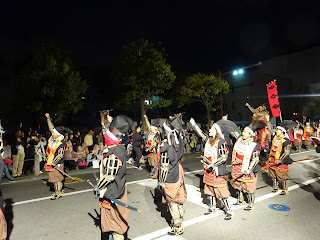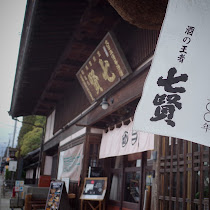Written by Kendra Evans
Aside from the usual food stalls,
performances and music that accompany Japanese festivals, the Shingen-ko
Festival also has something unique: a samurai parade. Takeda Shingen (played by
a famous actor) leads his 24 historical retainers and their battalions through
the streets of Kofu; groups representing companies, local businesses, and city
governments. Altogether, around 1500 people make up these battalions. Dressed
as samurai, their parade around the city was recognized by the Guinness World
Book of Records in 2012 as the world’s largest samurai parade.
The Yamanashi Prefectural Government has
been working with Garuda Indonesia, the national airline for Indonesia for many
years now, and on a visit to Indonesia last year, Governor Goto invited
representatives to attend the festival. They accepted, and this year was the
debut of the Garuda Indonesia Battalion in the samurai parade. Jusman Syafii
Djamal, President Commissioner of Garuda Indonesia, led the group as the
General. Members included not only Garuda Indonesia representatives, but also
Rahmat Gobel, a leading businessman from Indonesia whose Gobel Group recently
merged with Chateraise, a popular bakery chain from Yamanashi. He brought along
with him many colleagues and friends, including Indonesian celebrities. Other
Indonesians living and working in Japan also joined the battalion.
 To celebrate their debut, a dinner was held
at Kofu Fujiya Hotel in Kofu for the guests the evening before the festival.
The women were invited to wear kimono during the dinner, and I assisted in
putting on the outfits. Kimonos are very complicated to put on, and there are
many styles. It took about fifteen to twenty minutes to put the kimono on each
person, but they looked amazing once it was finished!
To celebrate their debut, a dinner was held
at Kofu Fujiya Hotel in Kofu for the guests the evening before the festival.
The women were invited to wear kimono during the dinner, and I assisted in
putting on the outfits. Kimonos are very complicated to put on, and there are
many styles. It took about fifteen to twenty minutes to put the kimono on each
person, but they looked amazing once it was finished!
The dinner included traditional dishes such
as Yamanashi hoto noodles and Kai salmon. There were
speeches given by the President Commissioner of Garuda, Rahmat Gobel and the
Yamanashi Governor, and many gifts were exchanged between the two. After the
dinner, there was plenty of singing and entertainment as well, before the group
headed to bed, ready to rest before the main event.

The day of the festival began cloudy,
threatening rain. Our guests arrived ready to try on more clothes – this time,
the samurai costumes. The samurai clothing has many, many layers. First you
begin with the socks, or tabi. These
socks separate the big toe, allowing for Japanese shoes where the strap goes
between the toes to be worn without discomfort. Next is the juban, the white undershirt, followed by
the wide trousers. For this style of clothing, the trousers have straps on the
knee and the ankle, which you use to tie them tight around the leg. They are
also tied around the waist to keep them up. After the trousers, there are the fabric
shin covers, which are also tied around the lower leg, and then the arm covers,
which are tied over the body and under the arm.
 The shoes are put on next. Waraji are thick straw sandals, which
are tied onto the foot in a specific way so as to keep them in place. Since they
are straw, there is not much support for your feet, especially during the
parade!
The shoes are put on next. Waraji are thick straw sandals, which
are tied onto the foot in a specific way so as to keep them in place. Since they
are straw, there is not much support for your feet, especially during the
parade!
Next is the yoroi, or armour. In this case it is a one piece which is strung
over the shoulders and then fastened around the body. Although it is plastic,
it was still heavy for our guests to wear for the entire day! The sword and
dagger are tied around this armour with thick fabric, to be kept in place at
one’s side. Lastly, they put on the hat. The look is complete!
We had 17 women putting on the samurai
clothes in the morning. It was quite complicated, and we who were helping had
to learn how to tie everything very quickly! Although it was tough to wear the
outfit the entire day, the team was all very enthusiastic, and no one
complained!
The group emerged from the Diet Building to
see the opening ceremony at the Prefectural Office. Many honoured guests and
festival participants, such as Mr Djamal and Mr Gobel, took part in the
ceremony, giving short speeches in front of the crowd before cracking open the
caskets of sake as a sign of the
start of the Shingen-ko Festival.
After the opening ceremony, everyone was
free to wander around the festival. At the Prefectural Office, there was sake, popcorn, and candyfloss, as well
as activities and entertainment like Taiko drumming. The weather was warmer
than we expected, as the clouds had cleared, so everyone took it easy and
enjoyed what was around.

After that, it was on to parade practice.
Around the back of the Prefectural Office all the battalions gathered, to take
official photographs and practice their formation. Here we were able to see
many other battalions, such as Koshu City Battalion, in which a couple of ALTs
were participating, and the JTB Battalion, where an Indonesian colleague was
marching in one of the front positions, and banging the bell.
Everyone lined up for their commemorative
photo, and then practiced their chant. They had good loud voices, helping get
the other battalions pumped up!
Once they finished, they started on the move
to Kofu Castle. The sakura in the Castle Park looked stunning in the
background, as a small crowd clapped and cheered the samurai on.
On the stage in the castle, a show was
being performed, reenacting tales from the life of Takeda Shingen. It was
mostly medieval Japanese, so it was hard to understand what was happening – and
even harder for our guests!
 During this time, one of our samurai, Dona, gave a
live interview for the TV coverage of the event. People were very interested to
hear about this new battalion from abroad!
During this time, one of our samurai, Dona, gave a
live interview for the TV coverage of the event. People were very interested to
hear about this new battalion from abroad!
Once Takeda Shingen donned his famous
helmet and set off with his retainers, each battalion heard the battle cry of
their leader from the stage, and followed after Shingen. Mr Djamal also gave
his battle cry in medieval Japanese; very impressive!
And thus the parade began. It started at
the castle, and then headed to Kofu Station. There, the leader split from his
battalion in order to get on his horse. I hadn’t known that there were horses
in the parade, and I was so surprised! It’s not often that you see them in
Yamanashi, and they had come all the way from Kobuchizawa.
 The streets were packed with people
watching and cheering on the group. The pace was slow, but in the shoes I’m
sure it was very grueling, and having the crowd encouraging everyone certainly
lifted the spirits. The entire parade was being filmed, and as we passed
certain places such as Yamanashi Plaza, you could see the close ups of the
battalion leaders, and the parade behind and in front of us from the wide
screens up on the walls.
The streets were packed with people
watching and cheering on the group. The pace was slow, but in the shoes I’m
sure it was very grueling, and having the crowd encouraging everyone certainly
lifted the spirits. The entire parade was being filmed, and as we passed
certain places such as Yamanashi Plaza, you could see the close ups of the
battalion leaders, and the parade behind and in front of us from the wide
screens up on the walls.
From the station, the parade continued
along Heiwa-dori, then turned towards Okajima, around the City Hall. Our
battalion chanted along with the crowds, and even gave out some high-fives to
children along the street. It was dark by this time, but the bright lights
illuminating the parade guided the way. Thankfully it didn’t rain at all!
Our battalion returned to the Prefectural
Office, instead of going back to the castle. When they got back, everyone
rushed to take off the armour! The Garuda Indonesia Battalion worked very hard
and stayed cheerful and energetic throughout the whole parade. I hope they
enjoyed it - it was a pleasure to work with them.
The festival was a big success, and over
145,000 people attended over the three days. I hope that Garuda Indonesia
decide to participate again next year! I’m sure I will come again as a tourist,
so I can see even more of the festival. You should come and see it in real life
too!
























https://www.youtube.com/watch?v=SFlp6CHA2nY&t=36s
ReplyDelete